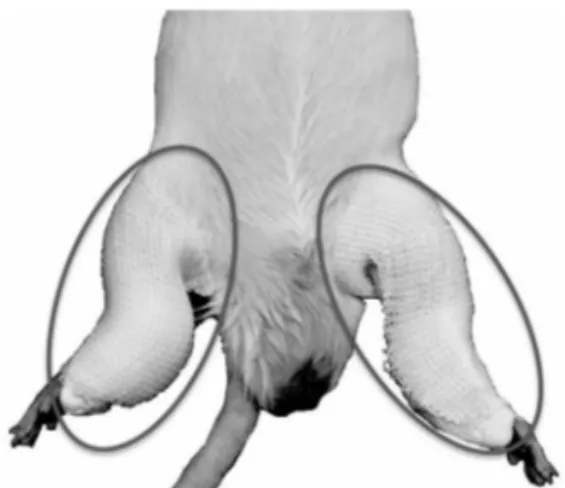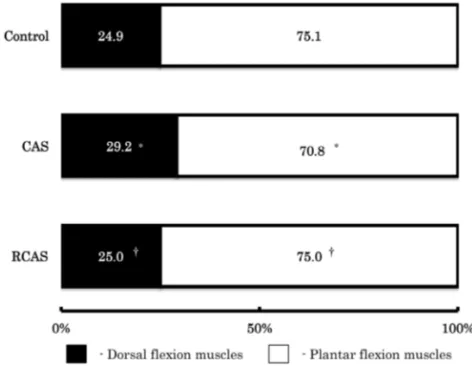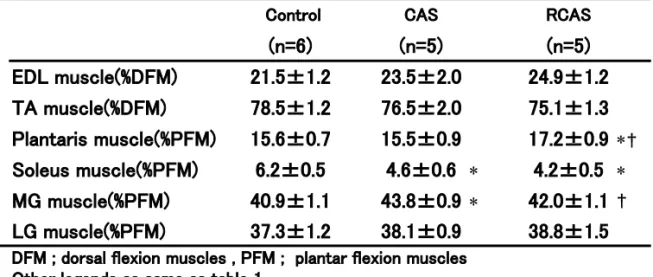著者 辻本 尚弥
雑誌名 久留米大学健康・スポーツ科学センター研究紀要
巻 22
ページ 11‑21
発行年 2015‑03‑01
URL http://hdl.handle.net/11316/341
緒 言
実験動物を用いた後肢のギプス固定によるモ デルは、不活動あるいは不使用による骨格筋の萎 縮メカニズムを明らかにするために開発された1,
2)。後肢ギプス固定により骨格筋は、細胞サイズ、
細胞数とそれらの変化を反映した筋重量および
筋線維タイプなどの変化が短期間で引き起こさ
れる1-14)。また後肢ギプス固定を解除し通常飼育
に戻した場合、筋の構造と機能および筋量は、あ る程度の時間は要するものの回復することが報 告されている15-19)。
ラット後肢骨格筋は、解剖学的な位置や機能的 な違いにより足関節の底屈あるいは背屈に働く
=原著論文=
ラット後肢骨格筋に対するギプス固定解除の影響 Effects of the Removal of the Cast on Hindlimb Skeletal Muscle in Rats.
辻 本 尚 弥
1)、鈴 木 英 樹
2)Hisaya TSUJIMOTO
1), Hideki SUZUKI
2)Abstract
We studied the effects of continuous cast immobilization and those after removal of the cast on the weights of hindlimb skeletal muscles in male mature Sprague-Dawley rats (8 weeks old). The animals were divided into three groups: sedentary control (n = 6), cast-immobilized (CAS; n = 5) and recovery after cast-immobilization off (RCAS;
n=5). Animals in the CAS and RCAS groups were immobilized at the knee and foot joints for 10 days. After 10 days of immobilization, rats in the RCAS group were released from the cast and were reared in normal conditions for 7 days. Rats in the sedentary control and CAS group were provided after 10 days of cast-immobilization and those in the RCAS group were provided at 7 days after the cast was removed. The extensor (extensor digitorum longus and tibialis anterior) and flexor (soleus, plantaris, medial gastrocnemius and lateral gastrocnemius) muscles were isolated and weighed.
Muscle weight and relative muscle weight were significantly lower in the CAS group than in the sedentary control group, whereas these weights were significantly higher in the RCAS group than in the CAS group, except for the soleus muscle. In the CAS group, plantar flexion muscles were more atrophied than dorsal flexion muscles. In the CAS and the RCAS groups, no statistical differences were found between plantar and dorsal flexion muscle weight relative to muscle weights of the sedentary control group. In particular, the soleus muscle atrophied extensively and did not recover completely.
These results indicate that the effects of cast immobilization and cast immobilization off are different between plantar flexion muscles and dorsal flexion muscles.
Key words; Sprague-Dawley rat, extensor muscle weight, flexor muscle weight
1)久留米大学 健康・スポーツ科学センター 2)愛知教育大学 保健体育講座
Fig 1. The photograph of a cast-immobilization model.
Legends: The portion enclosed with a black line was a cast-immobilization part.
伸筋、底屈筋としてヒラメ筋、足底筋、外側腓腹 筋および内側腓腹筋を摘出し重量を測定した。重 量計測後、体量で除して各筋の相対的筋重量を求 めた。算出した相対的筋重量をもとに、対照群お よび CAS 群の値に対する相対値を算出した。ま た摘出した全ての筋の総量を全筋重量とした。さ らに前脛骨筋と長指伸筋重量の総計を背屈筋群 重量、ヒラメ筋、足底筋、外側腓腹筋および内側 腓腹筋の総計を底屈筋群重量とした。算出した全 筋、背屈筋群および底屈筋群の各重量をもとに、
対照群および CAS 群の値に対する相対値と、背 屈筋群と底屈筋群の相対比を算出した。さらに、
全筋、背屈筋群および底屈筋群に対する各筋の相 対比を求めた。なお飼育および屠殺でのラットの 取り扱いについては、「実験動物の飼養及び保管 並びに苦痛の軽減に関する基準」に沿って行った
32,33)。ギプス固定群では、後肢固定部に異常な浮
腫や壊死が観察されたものは、事前にサンプルよ り除外した。
各測定値は群ごとに平均値及び標準偏差を求 め統計学的な検定を行った。組織重量及び相対的 組織重量では、一要因の分散分析をし、その後そ れぞれの群を比較した。全ての検定は、統計解析 ソフト R を用い、有意水準は 5%(p<0.05)とし た34,35,36)。
筋群に分けられる。これらの筋は、ラットの移動 や探餌、引水など自発行動において、それぞれ活 動パターンや活動量が異なる20-23)。さらに筋を 構成する筋線維タイプや構成物質も異なる24-27)。 我々は、ラット後肢をギプス固定し足関節の底屈 および背屈を全て制限した場合に、各筋群の骨格 筋重量の変化は一様ではなく、足関節の底屈筋群 と背屈筋群で異なる変化の様相を示すことを報 告してきた28-31)。
本研究では、後肢ギプス固定を解除し、筋の活 動パターンや量を制限前に戻した場合の適応変 化を詳細に検討するために、実験動物のラットを 用いて、解剖学的位置および機能が異なる筋群 の、後肢ギプス固定後解除による回復過程での影 響について明らかにする事を目的とした。
方 法
実験動物には、生後 8 週齢の Sprague-Dawley 系雄性ラットを用いた(日本 SLC)。実験群とし て、対照群(Sedentary control, n=6)、ギプス固 定 群(Cast-immobilization;CAS 群 , n=5)、ギ プス固定解除後の回復群(Recovery after cast- immobilization off;RCAS 群 , n=5)の 3 群を設 けた。ラットはステンレス製ワイヤーケージに て、昼夜逆転した 12 時間の明暗サイクルで室温 23±1℃、湿度 60±5% の環境下で飼育した。飲 水は自由摂取とした。摂餌については CAS およ び RCAS 群を自由給餌とし、対照群は CAS 群に 対する pair-feeding とした ( 餌 , CE-2: 日本クレ ア )。CAS 群および RCAS 群には 8 週齢時に麻酔 下にて、後肢を弛緩させた状態で、膝関節および 足関節を包帯式ギプス ( スコッチキャスト ; 住友 スリーエム社 ) で 10 日間固定した28-31)(Fig.1)。
RCAS 群は 10 日間の固定終了後ギプスを解除 し、通常飼育に戻した。対照群および CAS 群は固 定終了後、RCAS 群はギプス固定を解除した 7 日 後、ラットを麻酔下にて頚動脈より放血し屠殺し た。その後、後肢の背屈筋として前脛骨筋と長指
Table 1. Body weight and skeletal muscle weights of rat in each group.
Control CAS RCAS
(n=6) (n=5) (n=5)
Body weight (g) 337±19 230±17 ∗ 291±19 ∗ † EDL muscle(mg) 157±14 104±13 ∗ 141±15 † TA muscle(mg) 574±45 339±42 ∗ 427±55 ∗ Plantaris muscle(mg) 344±36 168±29 ∗ 292±15 ∗ † Soleus muscle(mg) 136±12 49±12 ∗ 72±13 ∗ MG muscle(mg) 826±78 389±55 ∗ 626±60 ∗ † LG muscle(mg) 904±59 478±78 ∗ 711±66 ∗ † Values are expressed as mean ± SD
CAS ; cast-immobilization , RCAS ; recovery after cast-immobilization off EDL ; Extensor digitorum longus, TA ; Tibialis anterior
MG ; medial gastrocnemius, LG ; lateral gastrocnemius
∗ : Significant difference from the value in control group (p<0.05).
† : Significant difference from the value in CAS(p<0.05).
Table 2. Relative skeletal muscle weights of rat in each group.
Control CAS RCAS
(mg/g body weight)
(n=6) (n=5) (n=5)
EDL muscle 0.47±0.03 0.45±0.04 0.49±0.05 TA muscle 1.70±0.06 1.48±0.18 ∗ 1.47±0.13 ∗ Plantaris muscle 1.02±0.06 0.73±0.11 ∗ 1.01±0.07 † Soleus muscle 0.40±0.03 0.21±0.04 ∗ 0.25±0.03 ∗ MG muscle 2.45±0.16 1.69±0.17 ∗ 2.15±0.07 ∗ † LG muscle 2.68±0.16 2.06±0.26 ∗ 2.44±0.16 ∗ † Legends as same as table 1.
結 果
表 1 には体重および長指伸筋と前脛骨筋、足底 筋、ヒラメ筋、内側腓腹筋および外側腓腹筋の各 組織重量を平均値と標準偏差により示した。体 重は、対照群に対して CAS 群および RCAS 群が 低値を示した。CAS 群の体重は、対照群に対し て 68% であり、ギプス固定の影響がみられた。
RCAS 群の体重は CAS 群に比べ高値を示し、ギ プス固定の解除により回復がみられた。しかし、
対照群に対しての相対値は 86% であり回復が十 分ではなかった。
各骨格筋の重量について、CAS 群は対照群に 対して全ての筋において低値を示し、RCAS 群で は長指伸筋を除く他の筋において対照群に対し て低値を示した。RCAS 群では CAS 群に対して、
長指伸筋、足底筋、外側腓腹筋および内側腓腹筋 において高値を示した。各骨格筋の相対的重量 を平均値と標準偏差により表 2 に示した。相対的 骨格筋重量では、CAS 群において長指伸筋を除
'""'.&0"0'/".* *).,*'*,0'/"*#(/- '"1"&$%.&)" %$,*/+
*).,*'
(/- '"
(/- '"
').,&-(/- '"
*'"/-(/- '"
(/- '"
(/- '"
'/"-&).%"+,").%"-&-*#,","'.&0"0'/".* -.&((*&'&2.&*) .%",'"$")!---("-.'"
'""'.&0"0'/".* *).,*'*,0'/"*#,"'.&0"(/- '"1"&$%.&)" %$,*/+
*).,*'
(/- '"
(/- '"
').,&-(/- '"
*'"/-(/- '"
(/- '"
(/- '"
'/"-&).%"+,").%"-&-*#,","'.&0"0'/".* -.&((*&'&2.&*) .%",'"$")!---("-.'"
く他の筋において、対照群に対して低値を示し た。RCAS 群では長指伸筋と足底筋を除く他の筋 において対照群に対して低値を示した。RCAS 群 では、足底筋、外側および内側の腓腹筋において CAS 群に対して高値を示した。長指伸筋のみ全 ての群間において有意な差は認められなかった。
表 3 には各筋重量の対象群と CAS 群に対する相 対比を示した。CAS 群ではすべての筋で低値を 示し、特にヒラメ筋がもっとも低値を示した。
RCAS 群では内側腓腹筋と長指伸筋で高い値を 示し回復がみられたが、その他の筋は CAS 群と 同様に対象群に対して低値を示した。RCAS 群と CAS 群の比較では、ばらつきが見られるものす べての筋で 100% を上回り、ギプス固定の解除に
よる回復がみられた。表 4 には各相対的筋重量の 対象群と CAS 群に対する相対比を示した。CAS 群では表 3 の結果と同様な傾向を示した。RCAS 群の CAS 群に対する値も表 3 の結果と同傾向を 示した。表 3 および表 4 の結果をみると、ヒラメ 筋において他の筋に比べ萎縮の程度が大きいこ とと回復が遅いことが明らかとなった。
表 5 には全筋と足関節底屈筋群、足関節背屈筋 群の各重量を平均値と標準偏差により示した。ま た全筋および各筋群重量の対象群と CAS 群に対 する相対比を示した。全筋と足関節の底屈筋群お よび背屈筋群の各重量は、対象群に比べて CAS 群および RCAS 群で低値を示し、RCAS 群で CAS 群に比べ高値を示した。これらの傾向は相対比と
Fig 2. The percentage of the dorsal flexion muscles or plantar flexion muscles to the whole muscle weight.
Other legends as same as table 1.
Table 5. Whole muscle weight and dorsal or plantar flexion musclses weights in each group.
Control CAS RCAS
(mg) (n=6) (n=5) (n=5)
Whole muscle weight 2942±220 1523±217 ∗ 2270±189 ∗ †
100 51.8 77.3 (149.0)
Dorsal flexion muscles weight 731±55 443±51 ∗ 568±67 ∗ †
100 60.6 77.7 (128.2)
Plantar flexion muscles weight 2210±169 1080±170 ∗ 1701±141 ∗ †
100 48.9 77.0 (157.5)
Values of lower row are relative value to control.
Values in the parenthesis of RCAS are relative value to cast-immobilization.
Other legends as same as table 1.
して示した場合も同様の傾向であった。足関節底 屈筋群と背屈筋群の各重量および相対比の変化 をみると、萎縮および回復の程度ともに足関節背 屈筋群が底屈筋群に比べ小さく、筋重量を指標と したギプス固定の影響は、ラットにおいて後肢足 関節底屈筋群において大きいことが示された。図
2 には、全筋重量に占める足関節の底屈筋群と底 屈筋群の構成比を示した。底屈筋群の構成比は、
CAS 群において対象群および RCAS 群の両群に 比べ低値を示した。このことからも表 5 の結果と 同様に、ギプス固定の影響は後肢の足関節底屈筋 群において大きいことが明らかとなった。
Table 6. Relative value to whole muscle weight in each group.
Control CAS RCAS
(% whole muscle weight) (n=6) (n=5) (n=5)
EDL muscle 5.3±0.4 6.8±0.6 ∗ 6.2±0.6
TA muscle 19.5±0.4 22.3±1.2 ∗ 18.8±1.4 † Plantaris muscle 11.7±0.6 11.0±0.6 12.9±0.8 † Soleus muscle 4.2±0.3 3.2±0.4 ∗ 3.2±0.4 ∗
MG muscle 30.8±0.8 31.0±1.0 31.3±1.4
LG muscle 28.1±1.0 25.6±0.6 ∗ 27.6±1.0 † Other legends as same as table 1.
Table 7. Relative value to dorsal flexion or to plantar flexion muscles weights in each group.
Control CAS RCAS
(n=6) (n=5) (n=5)
EDL muscle(%DFM) 21.5±1.2 23.5±2.0 24.9±1.2 TA muscle(%DFM) 78.5±1.2 76.5±2.0 75.1±1.3 Plantaris muscle(%PFM) 15.6±0.7 15.5±0.9 17.2±0.9 ∗ † Soleus muscle(%PFM) 6.2±0.5 4.6±0.6 ∗ 4.2±0.5 ∗ MG muscle(%PFM) 40.9±1.1 43.8±0.9 ∗ 42.0±1.1 † LG muscle(%PFM) 37.3±1.2 38.1±0.9 38.8±1.5 DFM ; dorsal flexion muscles , PFM ; plantar flexion muscles
Other legends as same as table 1.
全筋重量に対する各筋重量の構成比を表 6 に 示した。対象群に対して CAS 群では、ヒラメ筋 および外側腓腹筋で低値を、長指伸筋および前脛 骨筋で高値を示した。RCAS 群ではヒラメ筋で対 象群に対して低値を示し、外側腓腹筋、前脛骨筋 および足底筋で CAS 群に対して高値を示した。
ヒラメ筋が CAS 群および RCAS 群の両群で、対 象群に対して低値を示したのは、これまでの結果 と同様に、萎縮の程度が大きく回復が遅いことを 示したものである。また足関節背屈筋である長 指伸筋および前脛骨筋において、対象群に対し
て CAS 群で高値を示し RCAS 群では差がみられ なかったことは、ギプス固定の影響が後肢の足関 節底屈筋群に比べ相対的に小さいことを示して いる。表 7 には、足関節の底屈筋群および背屈筋 群における各筋の構成比を示した。対象群に比べ CAS 群ではヒラメ筋が低値を、内側腓腹筋が高 値を示した。RCAS 群では対象群に比べ、ヒラメ 筋が低値を、足底筋が高値を示した。RCAS 群と CAS 群の比較では足底筋は RCAS 群が、内側腓 腹筋では CAS 群が高値を示した。長指伸筋およ び前脛骨筋においては差がみられなかった。
考 察
本研究では、後肢足関節の底屈および背屈動作 において働く骨格筋に対するギプス固定とその 解除による影響について検討し、以下の主な結果 を得た。ひとつは、ギプス固定の影響が、後肢の 足関節背屈筋群に比べて底屈筋群、特にヒラメ筋 において強く見られたことである。さらに後肢ギ プス固定の解除により、足関節底屈筋群の変化率 は大きいが、ヒラメ筋においては十分な回復が見 られなかったことである。
ギプス固定の影響が、後肢の足関節背屈筋群と 底屈筋群では異なったことは、ひとつには足関節 背屈筋群と底屈筋群を構成する各筋の筋線維タ イプが異なることが考えられる。本研究では、後 肢の足関節背屈筋群に比べ底屈筋群が萎縮し、そ の程度はヒラメ筋、内側腓腹筋、足底筋、外即腓 腹筋の順に大きかった。特にヒラメ筋において萎 縮が顕著に見られたことから、ヒラメ筋や内側腓 腹筋を構成しているスロータイプのタイプ I 線維 の萎縮と消失およびの構成比が萎縮の程度に影 響しているのではないかと考えられる。これまで 筋線維タイプの違いにより不活動や不使用の影 響が異なることが報告されている37-40)。骨格筋の 萎縮は、筋を構成するタンパク質の合成が低下し 分解が亢進することで引き起こされる41-44)。タン パク質の合成と分解は、細胞内情報伝達系の制御 をうけており、不活動や不使用はその情報伝達経 路に対して影響することが知られている45,46,47)。 我々は先の報告で、細胞膜上の種々のレセプター に対するギプス固定の影響について報告した
29,30,31)。その中で骨格筋によりギプス固定の影響
は異なり、それはタンパク合成や分解に影響する 幾つかのレセプターの発現量が筋線維タイプ別 で異なることが一因であると報告した29,30,31)。本 研究において足関節の背屈筋群と底屈筋群で萎 縮の程度が異なった理由も 、レセプターの発現 量やタンパク質の合成・分解に筋線維タイプで
違いが見られることと、その筋線維タイプ構成比 が異なることが影響したと考えられる。また足関 節背屈筋群と底屈筋群で回復期においても変化 の様相が異なったことは、初期状態としての萎縮 の程度の違いと、回復時においても、レセプター の発現量やタンパク合成・分解あるいは情報伝 達に関わる機構に、筋線維タイプによる違いが見 られることが影響するのかもしれない。
後肢の足関節背屈筋群と底屈筋群でギプス固 定の影響が異なった要因としては、さらに各筋の 固定状態が異なったことによるのかもしれない。
ラット後肢を過度に底屈あるいは背屈した状態 で固定した場合、ヒラメ筋と腓腹筋において萎縮 の程度が異なることが報告されている48)。また ラット後肢を最大底屈位で固定し、さらに固定期 間内に 1 日数十分の伸展を加えた場合、萎縮の程 度が軽減されるという報告がある49)。これらは 後肢の固定角度は後肢足関節の、特に背屈筋群の 萎縮の程度に対して影響を及ぼすことを示して いる。ラットの行動を観察すると、腹臥位、立位、
座位といった姿勢が多く観察される。ラット後肢 の解剖学的構造から推察すると、これらにおいて は下腿部と足部のなす角度(足関節角度)が足背 屈側に 90 度以下の場合が多いと考えられる。さ らに、マウスやラットの行動を観察した場合、1 日に 300 から 400 回程度行われる50)leaning や rearing の動作では、足関節角度が足底屈側に 90 度をこえてさらに伸展される状態にはならない と推察される。また探索あるいは探餌行動など移 動時に行われる locomotion 動作においても足関 節角度が足底屈側に 90 度をこえてさらに伸展さ れる状態にはならないと推察される。これらのこ とから、本研究でギプス固定の影響が、後肢の足 関節背屈筋群に比べ底屈筋群において強く見ら れたのは、ギプス固定時の関節角度が、各筋にお いて通常置かれている筋の状態に比べて、短縮し た状態となっていた可能性が考えられる。ラッ トの 1 日の行動において足関節角度が足底屈側 に 90 度をこえて伸展する動作が、どの程度行わ
れているのかについての詳細なデータは見られ ない。そのため関節固定角度の影響とさらに固定 からの回復時の行動による足関節の活動様態の 影響については不明である。人では骨折や筋や腱 の損傷において、手術後あるいは保存療法時に患 部を固定して予後あるいは治療の経過を診る。そ の際、適切な固定範囲と固定肢位 ( 関節角度 ) は 重要である。固定肢位については選択が可能なら ば、筋力維持のために効果的であり筋の短縮を防 ぐ51)筋に適度な tension がかかる肢位を選択す る。このことを考えると、ギプス固定の影響やメ カニズムの解明に関する研究の場合、どの筋を対 象にするかによってギプス固定の角度は重要な 意味を持つ。しかし、ギプス固定時の関節角度の 影響を詳細に検討した報告はみられない。それは ラット後肢の各骨格筋について normal な位置を 明確に定義する必要があるためであり、今後は、
ラットの行動と動作を定量化し、後肢の足底屈お よび背屈を引き起こす各骨格筋の normal な位置 を明確にした上で、ギプス固定時のいくつかの関 節角度による筋の構造的・機能的変化を検討す る必要があるのではないかと考えられる。
引用文献



